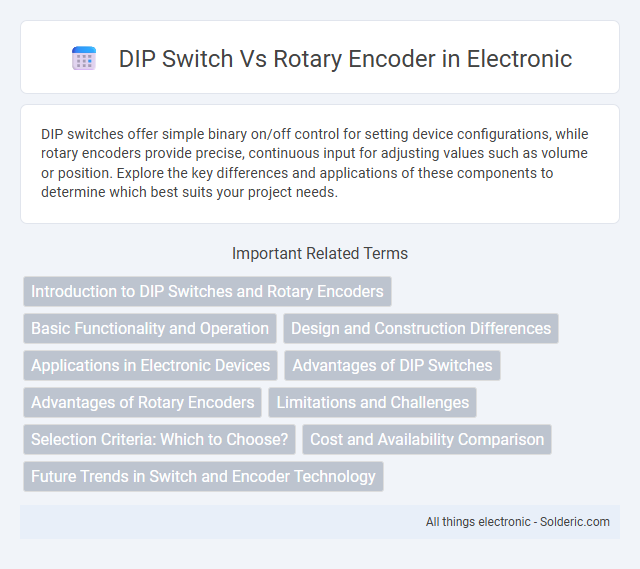DIP switches offer simple binary on/off control for setting device configurations, while rotary encoders provide precise, continuous input for adjusting values such as volume or position. Explore the key differences and applications of these components to determine which best suits your project needs.
Comparison Table
| Feature | DIP Switch | Rotary Encoder |
|---|---|---|
| Function | Manual binary setting for circuits | Rotational input device for position/speed |
| Output Type | On/Off (binary) | Incremental or absolute digital signals |
| Interface | Mechanical toggle switches | Rotary shaft with electrical contacts |
| Use Cases | Device configuration, addressing | User input controls, knob adjustments |
| Durability | High mechanical reliability | Subject to wear over time |
| Size | Compact multi-switch block | Typically larger, knob attached |
| Installation | PCB mounting or panel mount | Panel mount or integrated device |
| Cost | Low cost | Moderate to high cost |
| Programming Complexity | Simple digital read | Requires signal decoding or counters |
Introduction to DIP Switches and Rotary Encoders
DIP switches are compact, manual electrical switches used to set device configurations through binary ON/OFF positions, commonly found in hardware for selecting modes or addresses. Rotary encoders are electromechanical devices converting rotational position into digital signals, widely employed in control systems for precise input like volume adjustment or motor control. Each component offers distinct advantages: DIP switches provide simple, reliable static settings, while rotary encoders enable dynamic, high-resolution user interaction.
Basic Functionality and Operation
DIP switches are simple electromechanical devices allowing manual binary on/off settings, ideal for configuring hardware options through fixed positions. Rotary encoders convert angular position or motion into digital signals, providing precise input for controlling devices such as volume knobs or menu selections. Your choice depends on whether you need straightforward toggle settings (DIP switch) or continuous, adjustable control (rotary encoder).
Design and Construction Differences
DIP switches consist of a series of small toggle switches housed in a compact plastic package, allowing simple binary input changes through manual flipping. Rotary encoders feature a rotating shaft connected to digital or analog output signals, enabling precise measurement of angular position or incremental adjustments. The fundamental design difference lies in DIP switches providing discrete on/off states, while rotary encoders deliver continuous or incremental position feedback through mechanical rotation.
Applications in Electronic Devices
DIP switches are widely used in electronic devices for setting configuration options such as device addressing, mode selection, and feature enabling, especially in low-cost and simple circuit designs. Rotary encoders serve critical roles in user interfaces for precise control in applications like volume adjustment, menu navigation, and motor speed control in complex and interactive electronics. Electronic systems often choose DIP switches for straightforward binary settings, while rotary encoders are preferred for continuous, incremental input and ergonomic user experience.
Advantages of DIP Switches
DIP switches offer simple, reliable binary configuration settings that require no power, making them ideal for hardware-level customization. Their compact size and ease of integration into printed circuit boards enhance device durability and reduce manufacturing costs. Unlike rotary encoders, DIP switches provide tactile feedback with minimal risk of signal interference, ensuring precise and consistent manual control.
Advantages of Rotary Encoders
Rotary encoders offer precise position feedback and smoother control compared to DIP switches, making them ideal for applications requiring accurate adjustment and variable input. Their compact design supports easy integration into modern electronic devices with higher durability and longer lifespan under repeated use. Unlike DIP switches, rotary encoders can provide continuous rotation measurement, enhancing functionality in user interfaces and automation systems.
Limitations and Challenges
DIP switches face limitations such as limited switch positions, susceptibility to wear and environmental factors, and difficulty in automated reading, making them less ideal for complex or frequently changed settings. Rotary encoders offer more precise control and infinite position encoding but present challenges in complex signal interpretation and higher cost compared to DIP switches. Both components require careful consideration of application requirements, including durability, ease of integration, and scalability in design.
Selection Criteria: Which to Choose?
Selecting between a DIP switch and a rotary encoder depends on factors such as the required number of discrete settings and user interface complexity. DIP switches are ideal for simple on/off configurations with limited positions, offering cost-effective, reliable selection in compact spaces. Rotary encoders provide precise, infinitely variable input suitable for applications demanding fine control and frequent adjustments.
Cost and Availability Comparison
DIP switches are generally more cost-effective and widely available in standard electronic components catalogs, making them ideal for budget-sensitive projects and mass production. Rotary encoders tend to have higher unit costs due to their more complex mechanical design and require specialized suppliers, which can limit accessibility for small-scale or low-volume applications. The affordability and ease of sourcing DIP switches contribute to their preference in simple digital input settings, while rotary encoders are chosen when precise rotational input is necessary despite higher costs.
Future Trends in Switch and Encoder Technology
Future trends in switch and encoder technology focus on miniaturization, increased precision, and enhanced integration with IoT devices, enabling smarter and more adaptable user interfaces. DIP switches are evolving with improved durability and lower power consumption, while rotary encoders benefit from higher resolution and sensor fusion techniques for more accurate position feedback. Advancements in materials and wireless connectivity further drive innovation, making both technologies vital components in next-generation automation and control systems.
DIP switch vs rotary encoder Infographic

 solderic.com
solderic.com